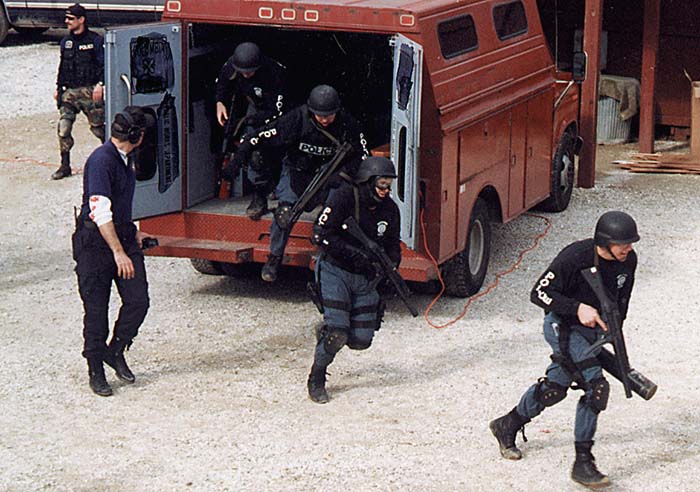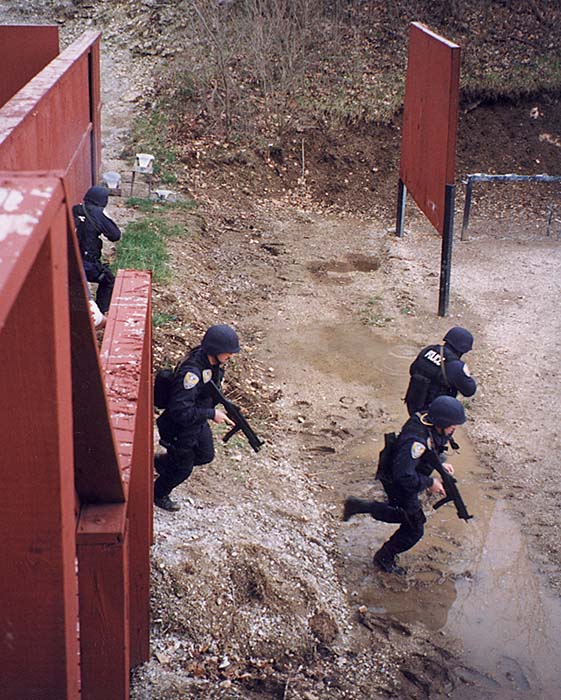By Sgt. Thomas Dresner
The sound was unmistakable. Automatic fire echoed through the rolling hills north of Columbia, Missouri starting shortly after 8 a.m. on April 4, 1998. From a distance, it might have sounded like an isolated skirmish in some far away country. It is the sound that occasionally causes nervous neighbors near a range to call the police to report it. Many of you have experienced just that near your ranges, because “Machine guns are illegal,” right?
No police were called today (they wouldn’t be anyway), because the police were doing the shooting. They were at the Chapman Academy of Practical Shooting/Green Valley Rifle and Pistol Club. They were competing in the first annual Midwest Police SWAT/SMG Championships.

Our tactical team is a member of the Kansas City Area Metro Tactical Officers Association, a group of teams that formed to share information about SWAT, coordinate training and sponsor training opportunities from outside sources. Myself and some officers from our team put together this match as not only a fun competition, but as a training event. Officers competing had to be from a working tactical team, and had to wear full call out gear, with BDUs, body armor, load bearing vests, and helmets if used by their teams.

We conceived the match as having four individual events, one two-man team event and one four man team event. The team events focused on the SWAT use of the submachine gun as we train, that is with officers firing on the move, in close proximity to each other using their training and proficiency to achieve surgical precision under adverse conditions.
To encourage surgical precision and to discourage fast firing without accuracy, we used a scoring system that gives us just that. It is called Chapman count, named for Ray Chapman, the great practical shooting patriarch who founded the shooting academy we shot on that day. This scoring system is quite simple. Standard IPSC targets are given values for the largest three areas on the target, and scored 10-4-2. Total time is then simply subtracted from score. This is a deviation from the usual 10-8-5, but we wanted to emphasize the importance of surgical precision that should be expected from an SMG shooter under SWAT conditions. As you can see, whoever shoots the most accurately, the fastest wins. Every hit not center of mass or in the head (10 points also) costs six seconds if in the C zone or eight seconds in D zone. With the SMG, we counted only the top two hits, but did not penalize for extra shots. Taking the time to do that is self-penalizing, since every second taken is a point lost. Also used were steel falling targets, worth 10 points each. They had to fall to count.
This scoring system will not allow a shooter to blaze all over the target with only peripheral hits and still win over one who tears out the center, but slower, as in IPSC, and more disappointingly, now IDPA. Center mass must be shot. And unlike in IPSC and IDPA, bad shots cannot be outrun.
Fifty-two officers from several departments in Missouri and Kansas competed for the plaques. They stood at the back of their cars, geared up, and got ready. We could have called this the Midwest MP5 championships, because that was the only SMG represented. Only one agency in our association has the Colt SMG, and they were not present. Among the variants were one PDW and four MP5SDs from Overland Park, KS PD, as well as MP5/40s from the Missouri State Highway Patrol SERT Team. Most were standard MP5A2s and A3s, usually with Navy or SEF trigger groups, some with burst groups.
This match emphasized the operational use of the SMG, and thus we established more ground rules to ensure that. All courses were fired in full auto, and no double magazine clamps were allowed. They do provide dramatically faster reloads, but are rarely carried operationally, because 60 rounds on the gun makes an MP5 very heavy. We simply required extra magazines to be carried on person. No optical sights were allowed either, though no teams use them anyway.
Because we required full auto fire, we designed the courses to be realistic in that respect. Almost all targets were between three and 12 yards away, and to further discourage imprecise fire, we placed some hostage targets directly behind steel shoot targets. One miss would cost 20 seconds and blow the stage for the officer. Civilian police tactical teams MUST ACCOUNT for every round fired, and one of the highest liabilities is for a team equipped with automatic firearms to allow ANY rounds to miss ANY target. The courses were designed with that as a primary rule.

Officers experiencing malfunctions were instructed to transition to their sidearm, before clearing the malfunction, as is standard SMG practice. Those who did not, were penalized. This was built into one course where the officer started with 10 rounds in the magazine, had to shoot dry, then transition before reloading and finishing the stage.
“Pain in the Gas”

A match called “Pain in the Gas” was fired with the competitor wearing his issued gas mask. This is one area where most teams practice very little, and the problems experienced were evident. Many officers fogged up and could not see, and just getting a decent MP5 sight picture with a gas mask is difficult for anyone who has ever tried it. Most team leaders left vowing to include more live fire training with gas masks in the future.
Because I am on the training committee for MTOA, I have a very good idea of the capabilities of the tactical teams in our organization. It is because they are of such competence that we could design a match that would be too dangerous for people who don’t train regularly together. Because they are so well trained, we could design exciting matches that would allow officers to fire through vehicles with open windows to targets on the other side, or to jump in the side door of a van and shoot at targets out the rear door, and even safely move up range, a real source of heartburn unless you have skilled operators.
Any match director contemplating a course where two and even four shooters are moving and shooting together would have to factor in his hair getting much grayer by match end. It is not normally contemplated, and again, without veteran tactical officers who train regularly competing, probably shouldn’t be. But with a core of training that emphasizes safe weapons handling, to include NO laser violations, moving with the finger off the trigger, and regular drills of firing on the move, this all becomes possible.

“Two to Tango”
Our two-man team event was called “Two to Tango.” It involved both officers engaging a series of 18 steel falling targets, some on the move, while negotiating door entries and shared areas of responsibility. A mandatory reload under cover prior to one door entry stipulated that only one officer could reload at a time, and they had to communicate with each other to make it smooth and quick. We mandated the reload this way to stay true to the operational concepts that we train. All targets down the fastest, with no hostage target hits wins the event. Officers Bryan Liebhart and Brad Nelson from our own Columbia PD STAR Team took first in this event.
“HRT-4-ME”

All four individual events and the two man team event were fired throughout the day with the extensive and ambitious four man team event being saved for last, after all other courses were complete. The crowd of spectators and families started to gather as setup commenced for “HRT-4-ME”, and soon I started with the course walk through and safety briefing for the ten four man teams that competed in this final event.
All four officers were to start in the back of a SWAT truck, each with an MP5, and one also carrying a battering ram. On the start signal, they were to exit the van and move to a door, where the officer with the ram simulated breaching it. They would then fan out to a pre-designated shooting lane where they move forward and engage three targets each on the move. A moving target with a two-inch balloon in the head started across in front of them, and before they could advance further, the balloon had to be broken.

They then moved in a line, much as they would toward a warrant service, guns at low ready, still selected to full, fingers off triggers, muzzles not crossing even the heels of the man in front of them. They moved to stairs that lead to a gantry over a bulletproof wall that separates two ranges. From there, a shooter begins engaging hostile falling plates below them, firing almost straight down, as the other team members descend the stairs on the other side and find themselves face to face with another array of falling plates.
As the team gets to the ground on the other side, the designated “sniper” takes off up range to a position behind a barricade where he must engage the final stop plate, across a creek and about 30 yards away, with a hostage target directly behind it. Here the rules state that he alone can take the only semi-auto selected shot of the day. But he can’t do it until all his teammates cross a finish line, and he can’t see them because his back is to them. They must, as all teams did, communicate their arrival and that he is clear to shoot.
Only one team hit the hostage, because an officer who did not select to semi and instead squeezed off a two round burst. That distance was too far for him to keep both rounds on the plate, and though he stopped the suspect, he hit the hostage nearly dead center as well. His team had the winning time, but that one mistake dropped them from first to sixth place in that event. Top honors for the four-man team event went to officers from the Buchanan County, Missouri Drug Strike Force.
By 5:00 p.m. the ranges fell silent and the gear was stowed. The competitors moved to the range house where dinner was being barbecued. As you moved through the crowd you could hear many recounting tales of how if only they had done this, or had avoided that, their hands up and bladed, holding an imaginary MP5, firing and this time running the course perfectly, or how if you wear the chin strap on a kevlar helmet under your chin instead of on it, you can’t shoot prone because the helmet covers your eyes. Teammates swap “war stories” from recent callouts and warrant services with their friends from other teams.
After the scores were tabulated, and dinner was eaten, myself and Officer Ben White, assistant match director, presented the trophies.
Top five individual officers were:
Champion: Lt. Mitch Brim, Shawnee, Kansas Police Department
Second: Officer Jerry Greene, Columbia, Missouri Police Department
Third: Officer Chuck Seawood, Overland Park, Kansas Police Department
Fourth: Officer George Gardner, North Kansas City, Missouri Police Department
Fifth: Officer Vaughan Baker, Lee’s Summit, Missouri Police Department
We intend to make this an annual event and plan to hold it in early April. It is open to any tactical team member of a federal, state, county or local police agency. If you would like more information about it, or wish simply to contact me, you can do so by email at tdresner@mail.coin.missouri.edu. or by mail at SAR.
| This article first appeared in Small Arms Review V2N1 (October 1998) |











